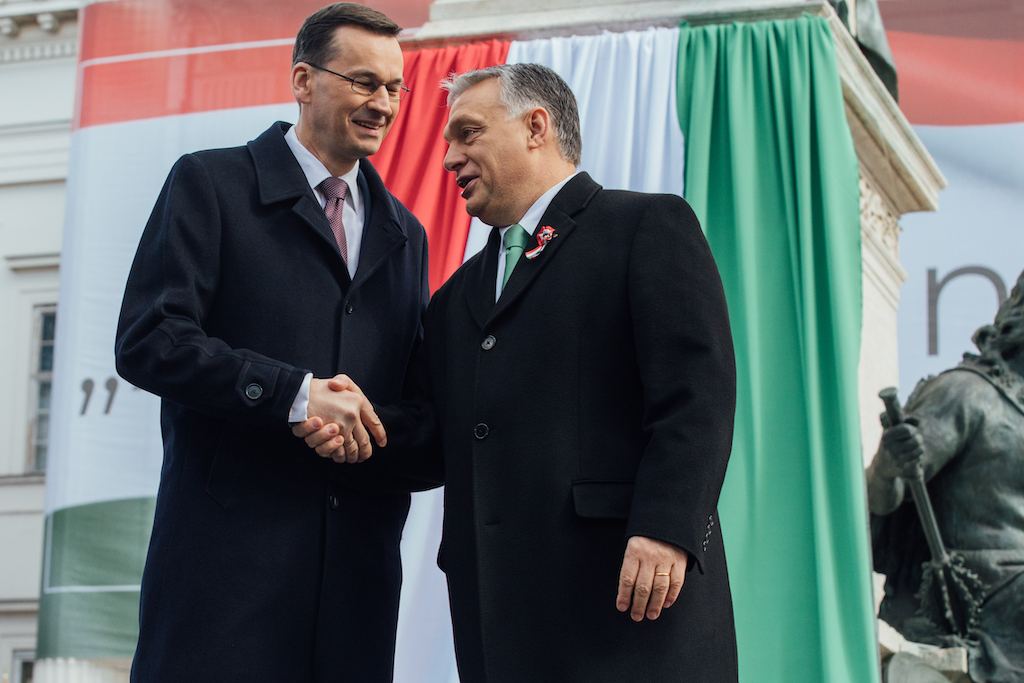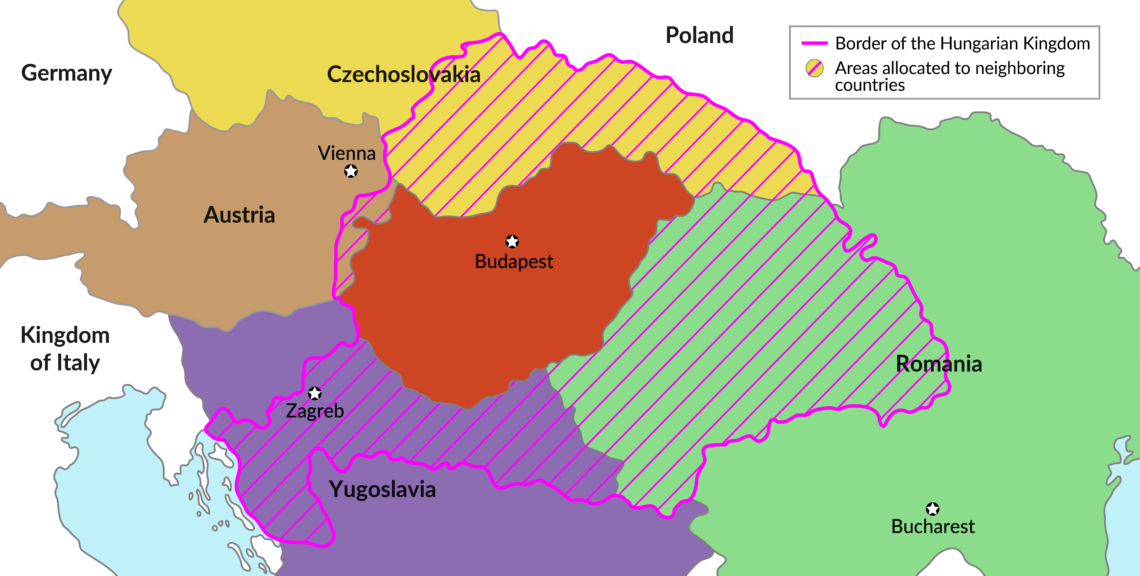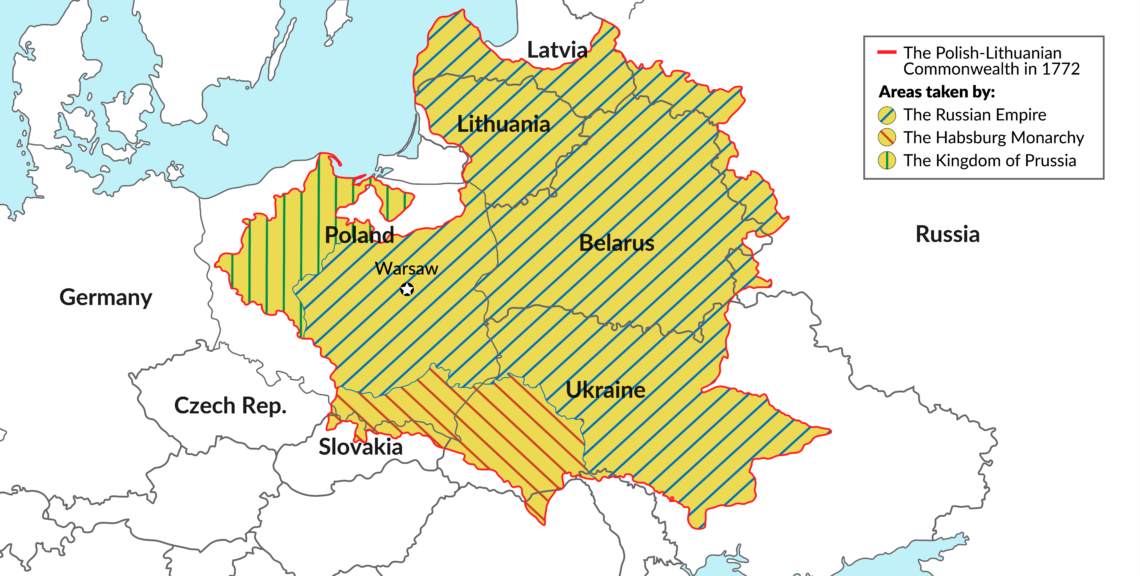Why Hungary and Poland are sticking together
When the leaders of Hungary and Poland jointly threatened to veto the EU’s Covid recovery fund last December, they argued it was in defense of their sovereignty. Both governments are rumbling down the path toward authoritarianism.

In a nutshell
- Hungary and Poland have joined forces to fend off criticism from Brussels
- Sovereignty is a sensitive issue in both countries because of historical trauma
- Both countries are experiencing democratic backsliding - but not in the same way
Poland and Hungary live in the long shadow of history. Last December, the two countries delivered a jolt to the European Union by threatening to veto its much awaited Covid recovery fund; they claimed to have done so in defense of their sovereignty.
However, to what extent can painful historical memories justify such antics? And what can one expect from the two former poster children of democratic transformation in Central Europe?
Hungary suffers from the “Trianon complex.” After the 1920 peace treaty signed in the Grand Trianon Palace in Versailles, the country was left landlocked and with less than a third of its pre-World War I territory. That traumatic experience underpins many aspects of Hungarian political life today.
The Poles, in turn, are extremely sensitive when it comes to their national independence.
Hidden drivers
Sovereignty was uppermost in the minds of the leaders of Poland’s first noncommunist government after 1989, repeatedly invoked by Prime Minister Tadeusz Mazowiecki (1989-1991) and Foreign Minister Krzysztof Skubiszewski (1989-1993). Poles had dreamt of regaining independent statehood ever since they lost it in the late 18th century. However, these days, sovereignty is not what it used to be.
While Poland longed for a traditional, fully-fledged national independence, the rules of statecraft had changed during the process of European integration and globalization.
Facts & figures

Some of Poland’s political elite are oblivious to this reality. After 1989, the country found itself voluntarily surrendering elements of its sovereignty to new supranational organizations. In the realm of security, that was NATO; border control, agricultural policy and other traditional state prerogatives went to EU institutions. Inevitably, someone in the country was bound to start claiming that Poland’s sovereignty was “stolen” and the EU “was like” the former Soviet Union, crimping the nation’s freedom and subjecting Poles to alien values and cultures.
These complexes have become hidden drivers of Hungarian and Polish politics. The Poles keep saying, “nobody is going to take our sovereignty from us again,” and the Hungarians, “we will not let anyone humiliate us.” Of course, both countries’ elites understand fully that Hungary cannot return to its pre-World War I borders and that Poland cannot thrive outside of the Union.
Facts & figures

The conservative governments that took power in 2010 (Hungary’s Fidesz) and 2015 (Poland’s Law and Justice, or PiS) cynically exploit the societies’ historical post-traumatic syndromes. The method boils down to elevating national wounds into nationalist policies. The goal is maintaining the two governments’ grip on power.
There was a period after 1989 when taking such a low road in politics seemed unthinkable in Central Europe’s new democracies. Particularly in Poland, comparing the EU to the Soviet bloc was not acceptable – until Donald Trump became the president of the United States and showed that everything goes.
A strong bond
Hungarian and Polish politics differ significantly from each other, but they also have some common features. They share historical experiences and a spiritual bond, expressed in the Polish saying, “Hungarian and Pole, two friends so fine; together they fight and drink their wine.” And both like to make references to brief personal unions the two kingdoms forged in the 14th and 15th centuries.
Interestingly, it does not seem to matter to Warsaw and Budapest that in the dark days of the 1930s, the two states made vastly different strategic choices. Hungary opted for a soft alliance with Hitler’s Germany but refused to help it logistically during the invasion of Poland in 1939. And Poland rejected Berlin’s offers of collaboration and became one of the first victims of German aggression.
Part of the answer to the mystery may lurk in the character of the leaders.
That the two countries have had no major territorial disputes and never waged wars against each other has helped them stand shoulder to shoulder in 2020. As members of the Soviet bloc and the military Warsaw Pact, both had watered-down, “softer” versions of communist governance systems.
A generation ago, Hungarian and Polish politics heroically achieved a peaceful transition from communism to democracy. Liberated from Moscow’s control, both states promptly shifted into the Western political orbit. Also, a rarity in the post-Soviet area, both managed to avoid the emergence of local oligarchs in their economic transformation. Hence the West’s shock that governments in these two countries now indulge in anti-Western propaganda and dismantle their democratic institutions, created from scratch only a short time ago.
What makes them tick
Part of the answer to the mystery may lurk in the character of the two states’ leaders. Hungary’s Prime Minister Viktor Orban and Poland’s Jaroslaw Kaczynski, who rules supreme over PiS, long felt marginalized by the once-popular liberal and left-wing parties. It hardly matters that both men were parts of the new democratic establishment and served as prime ministers in earlier years.
Their open admiration for pre-World War II autocrats, treated as heroes in the two countries, also seems to have played a role. In Hungary, that leader was Miklos Horthy, and in Poland, Jozef Pilsudski. In cultivating their conservative political images, Mr. Kaczynski and Prime Minister Orban also emphasize their religious allegiance. Both were initially centrist liberals.
For Mr. Kaczynski, who in the 1990s used to oppose mixing religion with politics, the turning point was his alliance with Redemptorist priest Father Tadeusz Rydzyk, the creator and “director” of the fundamentalist Catholic broadcasting station Radio Maryja. During elections, its agitation helped Mr. Kaczynski’s party, especially by mobilizing the electorate’s older and less educated segments.
Mr. Orban, who once identified himself as a Protestant and liberal democrat, also manifests his piousness and ties to the Catholic Church. During his visit to Poland last December 2020, at the height of the conflict with Brussels, the Hungarian prime minister took care to show himself on social media participating in an advent mass in a Warsaw church known for espousing nationalist ideology.
The men’s personal relationship is noteworthy as well. The Polish leader admits his admiration for Mr. Orban’s political skill and tries to emulate him. Mr. Kaczynski spoke of introducing the “Orban model” in Poland already in 2011. The Hungarian does not talk much of PiS, focusing instead on complimenting its leader personally when the two meet.
How Orban does it
Obviously, the development of Hungarian and Polish politics is not completely unfamiliar to Western states. The two societies, like many others, have fallen for the allure of populism – except they in the end may suffer more severe consequences.
The ruling style of Donald Trump played a discernible role in accelerating Poland’s and Hungary’s democratic regression. The Trump administration had no problems with the brutality, rule bending and nepotism of its staunchest European allies. In Poland, especially, the U.S. example carries much weight. Democratic institutions and political culture in this part of Europe are weaker than in many older Western states, so the damage the two countries incur may prove more lasting.
The prime minister behaved as if the town belonged to his country.
The Hungarian model of the “escape from democracy” rests on the manipulative use of the “Trianon complex” and Budapest’s claim that “Hungary is where Hungarians live.” After Fidesz returned to power in 2010 (after losing it in 2002), it granted ethnic Hungarians living in neighboring countries the right to vote in Hungarian elections. The move secured additional votes for the ruling party.
In 2019, this author had the opportunity to witness Mr. Orban’s visit to the Romanian city of Timisoara, which has a sizable Hungarian minority. The prime minister behaved as if he were the host, and the town belonged to his country. Under Mr. Orban, the Hungarian minority protection policy amounts to little more than intimidation attempts and shows of force, often directed at Slovakia and Ukraine. For example, Budapest did not hesitate to condition its support for Ukraine’s Western aspirations on concessions to its Hungarian minority.
The Orban government also made changes in Hungary’s domestic electoral law to ensure Fidesz remains in power even after losing popular support. Politically driven takeovers in the media sector have served the same purpose. Another startling development in Hungary is the emergence of an oligarch class. Several members of the prime minister’s inner circle have become very wealthy, apparently due to the government’s access to EU funds and policies that make rent-seeking possible for privileged insiders.
Hungary has become a ‘private state’ and the term ‘Orbanization’ stands for a gradual introduction of authoritarianism.
In foreign policy, the prime minister has steered the country toward close economic cooperation with Russia; in the energy sector in particular, Hungary is now dependent on Russia’s nuclear power technology and supplies. And to consolidate his electorate, Mr. Orban regularly launches intense smear campaigns. Their most frequent targets are Brussels and the EU, pro-democracy Hungary-born billionaire investor George Soros and Hungarian emigre circles.
As a result, Mr. Orban has created a governance system in which Hungary is a democracy in name only. His cliques dominate politics, business and the news media so completely that normal constitutional channels for power change are rendered ineffective. Hungary has become a “private state” of sorts, and the term “Orbanization” stands for a gradual introduction of authoritarianism.
Kaczynski’s way
In Poland’s 2015 parliamentary elections, the PiS-led conservative alliance campaigned under the “Good Change” slogan and the alleged need to raise the country from its “ruins” after eight years of center-right liberal rule. The idea caught on with many voters, but it was the introduction of a generous social benefit paid to families with newborn children that secured the most durable support for PiS.
Once in power, the new government took the Hungarian route of rigging the system to make its rule permanent. It loaded the Constitutional Tribunal with political lackeys and turned its public TV into crude propaganda channels. Also, it pressed hard to dismantle a system guarding judicial independence and replaced managements in all large state-controlled enterprises.
Its increasingly effective drive to take over the private media is based on buyouts by state-controlled firms. The ruling party also has been tinkering with bank nationalization schemes. Like Hungary, the Polish government regularly stirs aggressive media campaigns against the political opposition, immigrants and LGBT persons. In recent months, it drastically restricted abortion rights, prompting protests all over the country. All this serves to mobilize its conservative electorate and deepen Polish society’s already bitter divisions.
Not fully alike
What sets the two regimes apart is that Poland has not moved politically closer to Russia. The ruling coalition also lacks the votes needed to change Poland’s constitution, so it rams its “reforms” through the parliament, often in flagrant violation of its rules and existing laws. Its creation of authoritarian governance is slower and not as well coordinated. Poland’s political opposition retains a role; it has managed to take control of the Senate in 2019. In Hungary, the opposition is only beginning to learn how to unite.
Prime Minister Orban once presented a large map of the Kingdom of Hungary to Polish Prime Minister Mateusz Morawiecki. The problem with that pre-Trianon representation of the world is that Poland does not exist; it was then partitioned by mightier neighbors, one of them the Austro-Hungarian Empire. The Polish Prime Minister appears not to have brought this diplomatic faux pas to Mr. Orban’s attention. This is symptomatic of Polish-Hungarian relations at the moment: in this duet, Hungary leads. The December cliff-hanger in Brussels showed Mr. Orban is a far more skilled negotiator.
Strategically, Poland matters more to the West than Hungary, and Warsaw cannot afford to play the Russian card.
When it is to his advantage, the Hungarian shows extraordinary pragmatism in dealing with European institutions. For example, in March 2017, he voted to extend Donald Tusk’s term as president of the European Council – despite the Polish government’s determined lobby against it.
Looking at the EU Parliament, one sees that Hungary remains in the center-right European People’s Party (EPP), its largest party since 1999. Meanwhile, Mr. Kaczynski’s PiS is stuck with the European Conservatives and Reformists Party (ECR), a marginal faction since its locomotive, Great Britain, left the union.
Scenarios
Unpopular as Warsaw and Budapest may be in Brussels these days, the biggest challenge to them may come from the new administration in Washington. U.S. Secretary of State Antony Blinken declared that Donald Trump’s support for populist leaders needs reversing. Josep Borrell, head of EU diplomacy, has given him the EU’s blessing. While Mr. Orban is usually mentioned as an example of such populists, it was Messrs. Kaczynski and Morawiecki who drew comfort from Washington’s support. As they were fighting endless battles with Brussels, Polish officials felt President Trump had their backs.
Gradual improvement
Things are going to change now. Paradoxically, the U.S. policy shift may push Warsaw onto a less confrontational policy path with Brussels. Also, it may contribute to a loosening of its political partnership with Mr. Orban. Strategically, Poland matters more to the West than Hungary, and, in contrast to Budapest, Warsaw cannot afford to play the Russian card.
Rupture in Poland
One can imagine, of course, a scenario under which Budapest and Warsaw stick to their guns despite the change of political winds: they could continue to consolidate their autocratic governance models, harass the opposition, and violate EU rules. In response, EU institutions could marginalize the two member states, relegating them to the union’s periphery. In Poland’s case, such a scenario could ultimately cause a political rupture and open the way to the opposition’s victory – under pro-EU flag. Should this happen reasonably soon, the new government in Warsaw would need only to fix the damage in institutional infrastructure, the justice system and the media. Poland’s market economy is still reasonably sound.
New system in Hungary
However, the democratic backsliding in the two countries also could come to an end gradually, due to a strengthening of the opposition and adequate external pressure (mainly from Brussels, Washington and, less conspicuously, Berlin). In such a case, the restoration would be gradual too. Under this scenario, Hungary would undergo another systemic transformation, from autocracy to democracy. As opposed to a simple transfer of power, the country would witness the emergence of a reconstituted political system.
No simple returns
How, under the same gradual-change scenario, would Poland’s return to full democracy look? On the one hand, it could be a typical postelection adjustment, perhaps broader and deeper than usual, but not amounting to a systemic revolution. On the other hand, the victors could opt for launching a more spectacular, fast-line process of re-democratization of critical institutions and public life.
However, in both Hungarian and Polish politics, the return to status quo ante is not in the cards. Too much has transpired in these two countries, in the EU and the outside world to simply turn back time.








